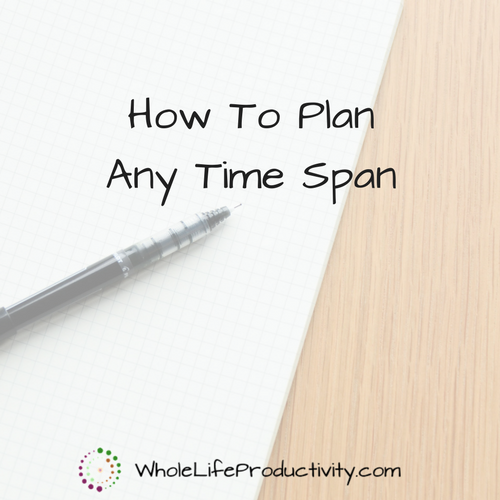
How To Plan Any Time Span
Are You Planning? Or Pretending?
I think one of the ironies of the modern productivity movement is that all of the bound notebooks are called “planners” and have little, if anything, to do with actual planning. They’re dangerous because they’re empty productivity – you feel productive, but it really doesn’t make you more productive. You’re pretending to be productive.
I fell in love with “planners” when I was in college, and I loved the way my Daytimer made me feel in control. However, these planners were not more than a calendar cobbled together with a task system. Even later planners, such as the Franklin Covey, which were based on actual planning systems, didn’t span the gap into planning the day.
“Vision without action is a daydream. Action without vision is a nightmare.” – Japanese Proverb”
Yet most systems are part of the second: action without vision.
What Is Planning?
Planning is the act of considering what you want to do, what you should do, and what you are committed to doing and fitting them all together so that you make the best use of your time.
Let’s dissect that a bit:
- What you want to do: generally speaking, if there is something that crops up on your list of things to do, and you just don’t want to do it, this is a sign that there is something wrong with the task. The strong resistance might be caused by vagueness in the task itself, not knowing exactly what it is that needs to be done. It might be caused by the task not originating with you; this could be someone else’s task, or an obligation that you feel you have to take on. Or it might be because the task is simply not important enough to warrant your attention. In all of these cases, your best chance of getting through tasks is to have a sense that you want to do them. In this category are all the tasks that will let you fulfill your dreams.
- What you should do: we all have commitments that come with being adults. We may not want to take out the garbage, but it has to be done. These tasks are such that you might feel resistance, but you know they have to be done, and the consequences are such that you just need to get them out of the way. These are often life maintenance tasks: housework, bill paying, grocery shopping, ferrying kids around and such.
- What you are committed to doing: these are things that make it onto your calendar, the pre-set appointments and commitments that you block out time for. I am not a fan of blocking out time to work on tasks, thereby leaving the calendar for the things you have committed to and will show up for without fail.
So planning is taking a look at all of your dream-inspired or project tasks, your day-to-day life tasks, and fitting them around those items that have a fixed time.
What Is Not Planning?
I see so many things that are labeled as planning, but really aren’t.
- Planning isn’t blocking off your calendar. Things never take the time we estimate.
- Planning isn’t writing a to-do list. A list can contain many things – and most people have too many things on their lists.
- Planning isn’t filling out a “planner”. Filling in forms without truly considering the items above is pointless. Forms can’t do your thinking.
- Planning isn’t about grouping tasks together. Grouping or batching tasks is good, but only if you have already considered your wants, shoulds and commitments.
- Planning isn’t about setting a theme. I see a trend of theming days going around. This means you decide what areas to focus on every day, such as email Mondays, writing Tuesdays, product creation Fridays, podcasting Thursdays. Themes are nice, but they’re just another grouping. (see above)
The Basics of Planning Any Time Frame
So how do you plan? It’s very straightforward – one of those simple concepts that can be hard to define.
I’ll be going into more detail later in this month, but for now let’s talk about the basics.
Step 1: have some way to write this plan down. It could be a blank piece of paper. It could be some sort of grid. But it needs to be written down so that it doesn’t become just a passing glance.
Step 2: write in your commitments. These are the big rocks around which we will have to plan the rest. Write in all the things you have committed to do with your time – and that includes your working hours. If you are out of the house for 9 hours, you are probably not going to be able to accomplish much of your personal stuff during that time.
Step 3: look at the shoulds. Life maintenance tasks have consequences if they are not done. Anyone who has let the garbage, dishes or laundry pile up too long has experienced this. Some tasks become exponentially larger if they are not attended to regularly. Anyone who has not cleaned the toilet or shower for a while knows what I mean. From your should list you have to walk the line of balance between effort and consequences, as well as effort now and effort later.
Step 4: estimate the time. You have tasks that will take time. Make sure you put an accurate (read: not wishful) estimate of how long it will take you. Include things like putting things away when you’re done.
Step 5: remove tasks if necessary from the should list. You don’t want to spend all of your free time doing “should” tasks. It leaves you no time to relax, and no time to move forward on the things you really want to get done.
Step 6: pick some wants. From here you can pick some tasks that you want to get done. These are your dream projects. These are your growth opportunities. Pick one (or two at most to work on), and then pick your tasks to move these projects forward.
Step 7: estimate the time. Just like you did for the shoulds, you need to know how long these tasks will take.
Step 8: remove tasks if necessary from the want list. Give yourself enough time to relax and get to bed at a decent hour (which I need to do, even as I write this…)
Summary
Planning is an important part of getting things … and the right things… done. Knowing what planning is, and isn’t, as well as the 8 basic steps to plan any time period can set you on your way.
Please forward this article with a friend. If you have gotten this article from a friend, please subscribe and get all the new articles directly in your inbox!




